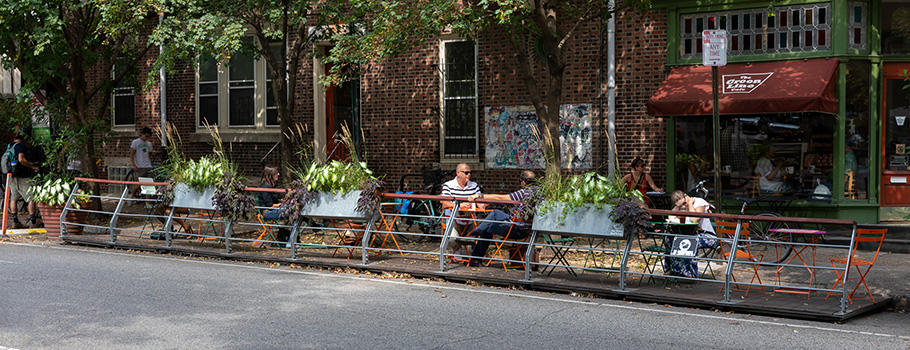Park(let) Here: Organizational and Demographic Preconditions for the Development of Parklets in Philadelphia
By Ariel Ben-Amos, Charlotte Castle, Cara Ferrentino, Andrew Simpson, Daniel Wolf
Parklets are small platforms that transform on-street parking spaces into small parks. They are a popular intervention associated with “tactical urbanism,” or the use of low-cost, temporary modifications to public spaces to enliven street life.

Since 2010, cities across the United States have established formal procedures for businesses or non-profits to establish parklets to improve conditions for pedestrians and promote commercial corridor activity. Research into parklets to date has largely focused on parklet design, impacts on parking supply, and the behaviors of parklet users as well as pedestrians. What is missing is a stronger understanding of where parklets will be successful and what some of the preconditions for that success are.
To support a better understanding of the factors behind a parklet’s success—where success is defined as installation for more than one year (or warm-weather season)—the authors surveyed the operators and non-profits who have installed, operated, and maintained over 12 parklets in Philadelphia. They also surveyed a control population of Philadelphia businesses and nonprofits. To consider the impacts of the built environment and demographics on parklet success more broadly, the authors analyzed the characteristics of all Census block groups containing parklets across America from 2010 to 2015.
Using surveys, Census data, as well as tax documents allowed the authors to compare the neighborhoods that host parklets with their cities as a whole, while also focusing more narrowly on the fundraising and staffing capacity of parklet hosts working through the administrative framework established by the City of Philadelphia. These data provide insight into the capacity of operators to manage public space, negotiate conflict, and interface with the government. What ultimately emerges is a better picture of the factors associated with a parklet’s success, and with alternative uses of parking spaces more generally.
READ THE WHOLE REPORT: Download the PDF